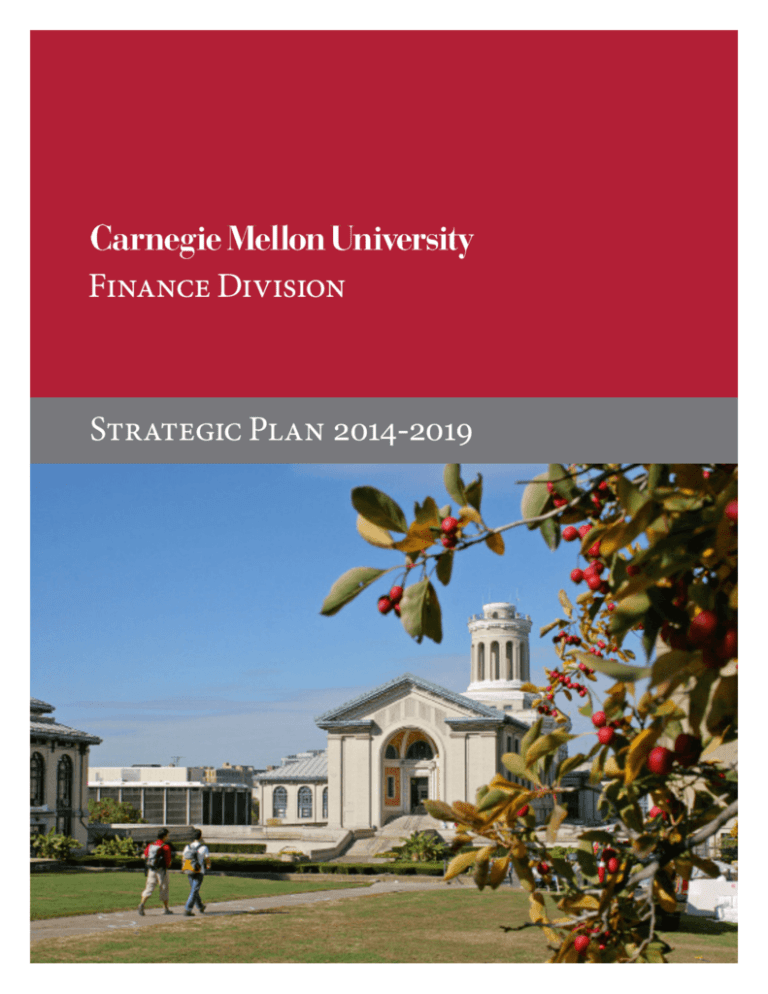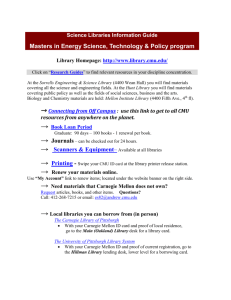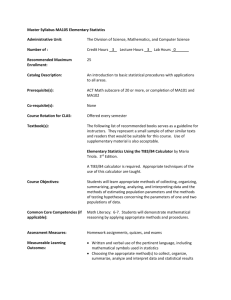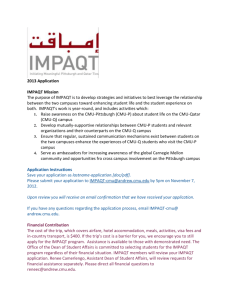Finance Division Strategic Plan 2014-2019
advertisement

Finance Division Strategic Plan 2014-2019 Introduction Finance Division T he Finance Division of Carnegie Mellon University (CMU) provides financial management, enterprise planning and stewardship in support of the education, research, and strategic goals of the university. The Vice President & Chief Financial Officer and his leadership team oversee Budget and Financial Planning, Controller’s Office, Financial Systems, International Finance, Sponsored Projects Accounting and Cost Analysis, CMUWorks Service Center, Treasury, University Audit Services, Campus Design and Facilities Development, and Computing Services units. Within those units lie critical business functions including, but not limited to payroll, financial reporting, accounts receivable and payable, procurement, the university purchasing card and expense reporting, and financial systems (see www.cmu.edu/finance for inclusive list). In addition to stewarding the university’s $1.1 billion[1] operating budget, members of the Finance Division share their expertise with 12,058 students and 5,425 staff and faculty.[2] We are proud to contribute to a top-tier global research university that has been a birthplace of innovation throughout its history. Purpose The purpose of the strategic plan is threefold: (1) to set and align organizational goals and priorities with those of the university; (2) to maintain the highest standards of service; and (3) to ensure the achievement of our goals through measurable standards. Because of limited resources, CMU must be strategic in allocating its resources to provide the greatest return to students, faculty and the university. By providing data, insight, and analysis, we assist leadership and the university community in the financial, space, and technology decisions that can fulfill its highest goals and priorities while maintaining a position of financial strength. [1]“Carnegie Mellon University Consolidated Financial Statements June 30, 2013 and 2012.” Carnegie Mellon University, 2013. Web. 3 Mar. 2014. <http://www.cmu.edu/finance/ reporting-and-incoming-funds/financial-reporting/files/2013_annual_report.pdf>. [2]“Factbook2013-2014,Vol.28-InstitutionalResearchandAnalysis-CarnegieMellonUniversity.” Factbook 2013-2014, Volume 28. Carnegie Mellon University, 2014. Web. 18 Mar. 2014. <http://www.cmu.edu/ira/factbook/facts2014.html>. 1 Mission & Values Our mission is to provide university partners and stakeholders with the tools and resources needed to be well informed leaders and effective decision makers. We provide data, information, analysis, knowledge and methods for our leaders to anticipate and respond effectively to the challenges facing the university. “ Outstanding people have one thing in common: an absolute sense of mission.” — Zig Ziglar The Finance Division exists to: n Act as Stewards of the financial resources entrusted to the university in support of its mission. (http://www.cmu.edu/about/mission.html) n Serve and Support students, faculty, staff, and others who have a vested interest in the financial activity and health of the university; to accomplish this, we share our knowledge and experience to advise on strategic financial planning and decision making, provide access to financial data, and ensure compliance with applicable laws and regulations. n Adhere to our Core Values including: • • • • Dedication to excellence, high ethical standards, and fiscal integrity in everything we do. Recognition of the talents, strengths, and contributions of our division’s people as well as our partners. Collaboration and communication in order to build strong bonds both internally and externally. Innovation in the products and services we provide while staying abreast of market trends and products that may present opportunities for the university. • Supporting the university community by designing, constructing, and acquiring high quality, innovative and efficient spaces that foster the teaching, learning and research goals of our students, faculty and staff. • Efficiency in business practices; demonstrating agility and adapting quickly to changing needs while providing direction and value in all applicable areas. • Excellence in customer service. 2 Vision The Finance Division is committed to being an exemplary organization that enables Carnegie Mellon to excel in academics, technology, research, and entrepreneurship. The division will strive to be a global business leader, recognized among the top university business divisions in the world in delivering expertise in business operations, finance, facility acquisition, design and construction, and information technology. The Finance Division will be an industry leader in innovation, institutional productivity and sustainability. This plan was created collaboratively with input from division leadership and staff, university leadership, and our stakeholders in the university financial community. We are grateful to everyone who provided their time, feedback, and vision in support of this strategic planning project. To reach our vision, we are dedicated to the following goals: • Commit to Excellence “ • Engage, Partner, and Collaborate • Empower Decision Making with Data • Cultivate, Recognize, and Reward our People • Shape a Culture of Innovation 3 Do your duty and a little more and the future will take care of itself.” — Andrew Carnegie Goals of the Finance Division Goal: Commit to Excellence Commit to excellence within the Finance Division by ensuring all processes and operations are necessary, clearly defined, and efficiently designed to align people, systems, and policies and to maximize productivity, improve efficiency and achieve higher quality and value. In order to be a valuable resource to the university, the Finance Division must commit itself to excellence. We must be a cohesive organization working together across departments, divisions and schools to enhance quality and excellence for the entire university. We will demonstrate excellence through participating in decision-making, implementing process improvements, adhering to the highest work and support standards, and striving to be the best in our industry. As business, financial, technology, and space experts, we have a responsibility to steward the finances and capital planning of the university. By identifying and recommending cost-saving mechanisms and revenue-generating ideas, the division will strengthen the financial position of the university and allow for continued excellence in education and research at CMU locally, domestically and internationally. The following strategies will be considered in the division’s strategic plan: • Establish a Finance and Business Center of Excellence to solicit, identify, evaluate, design, test, operationalize, and implement innovation; a center that will identify innovative ideas and processes; assess the impact on people; establish and utilize new technology; plan and execute innovation and measure its impact on cost-reduction, revenue-generation, institutional The first rule of any technology used productivity, and faculty and staff morale. “ • Evaluate current systems, policies and processes to identify opportunities to best optimize university resources by eliminating redundancies and by increasing automation and system functionality. • Streamline and improve the procurement process to maximize its value to the campus community and realize cost saving opportunities at both the unit and university level. • Fulfill the space demands of the university by planning, designing and constructing world-class academic and administrative spaces. in a business is that automation applied to an efficient operation will magnify the efficiency. The second is that automation applied to an inefficient operation will magnify the inefficiency.” — Bill Gates • Review and analyze all university property and space to help us understand current usage, ongoing maintenance costs, opportunities for consolidation. and • Identify opportunities for shared services internally between units and externally with community partners. • Define and implement project management processes and tool(s) that meet the needs of the division as well as the institution for portfolio and project management. 4 Goals of the Finance Division Goal: Engage, Partner, and Collaborate Engage, partner, and collaborate within the division and across the university by building frequent, targeted, and transparent communication for seamless services and improved customer satisfaction. “ Engagement, partnerships, and collaboration unify commuTeamwork is the ability to work together toward nities. The CMU global community, which consists of several schools and colleges, administrative units, and a student body, a common vision…It is the fuel that allows requires unification across, between, and within each of these common people to attain uncommon results.” audiences. As the division accountable for university technol– Andrew Carnegie ogy, finance business and space, it is the job of the Finance Division to share, educate, and connect our knowledge with the appropriate audiences. Combined with engagement, providing excellent customer service and resources to the university will secure our reputation as a valuable partner and advocate of university initiatives. Across the university, the people of the division are recognized as experts in our field. We must ensure that stakeholders receive the information and support needed through efficient channels. In order to provide excellent customer service, the ways in which we interact with our customers must be evaluated and redefined for improvement. It is imperative that we define our audiences and their needs. By taking a proactive approach to sharing the right information with the right people, we position ourselves as a valuable asset in the decision-making process at CMU. Crafting, sharing, and presenting unified messaging will solidify our reputation as a cohesive, responsive, and respected unit. The following strategies will be considered in the division’s strategic plan: • Review current support of and collaboration with other units, research best practices on customer service models within higher education, and develop and implement a support model for the division in collaboration with other units. • Consult with our stakeholders to obtain feedback, measure progress, and determine areas for improved partnership, collaboration, and engagement. • Collaborate within the division and with academic and administrative units to implement enterprise wide initiatives in order to support the campus community. • Initiate and maintain ongoing partnerships with internal and external stakeholders to share technical expertise, data, and other resources for problem-solving and strategic planning. • Communicate with the campus community by utilizing campus groups, implementing information-sharing forums, developing focused training sessions, and presenting road shows on finance and business topics. 5 Goals of the Finance Division Goal: Empower Decision Making with Data Integrate advances in information and systems technology to enhance the collection, structuring, and analysis of data for decision-making and change management. The decision making environment in higher education can be very complex. There are generally multiple stakeholders from various areas of the institution that need reliable access and require dynamic views and customized analysis of information in order to make Data are widely available; what is scarce is sound decisions. Requests for more timely and relevant data will the ability to extract wisdom from them.” steadily increase as constituents strive to make informed strategic – Hal Varian (UC Berkeley and Chief Economist, Google) and operational decisions. “ Improving the institution’s decision making capabilities means assessing and overcoming challenges. There needs to be a common understanding of where data reside, how to retrieve data in a manner that will provide the desired results and what data mean. Currently, university data are housed across several separate administrative systems. Often, academic units also have systems of their own to capture unit-specific data requirements. We need to break down barriers to the information that is housed across the various systems. Data need to be unified and provided in a meaningful way so that it is easily accessible, practicable and independent of the tools used to retrieve it. We must serve as a champion for data driven decision-making and provide campus with the support and resources to act in the same manner. In order to provide decision makers with a consistent data set that will empower responsible decision making, we must understand the questions, issues, and problems that the data should answer and address. The following strategies will be considered in the division’s strategic plan: • Assess institutional budgeting and planning approach in order to define strategies and solutions that will advance university strategic initiatives and strengthen financial sustainability. • Evaluate data available in financial systems as well as other administrative systems to identify and address gaps between the data available and the data desired. • Develop operational and analytical query tools for data analysis and reporting to strengthen operations and guide decision-making. Assess usage and effectiveness of reports and dashboards and evaluate opportunities to improve. • Create a community of business intelligence experts within the Finance Division and across the university who will share their expertise and best practices for developing tools and reports to increase analytical data-driven decision making. • Build executive dashboards and self-service mechanisms in conjunction with university leadership in order to utilize accurate and timely data in both operational and strategic decision making. • Conduct a university wide space audit. • Implement space and construction management software to support data-driven decision making in space planning and capital project management. 6 Goals of the Finance Division Goal: Cultivate, Recognize, and Reward our People Provide an infrastructure within the Finance Division that supports and cultivates our people through professional and personal development, recognizes and rewards the contributions made towards achieving the mission of the division and the university at large, and offers opportunities that position our people, as well as the division, for success. Our people are our single greatest asset and are recognized as experts in their respective fields. Our people are depended upon to provide reliable and accurate information, to uphold policies, to maintain systems, and to manage relationships with vendors, sponsors, and governing agencies. Our people also provide expertise to maximize utilization of space and technology. To retain our assets, we need to determine what motivates our people and respond accordingly. Supporting our people and attracting the best of the best requires the ability to demonstrate that we support the growth of our people. We need to provide a roadmap for career development within the division which includes expected competencies, professional development plans, and an overall architecture which will assist our people in achieving their career goals. We need to allow for personnel assessment in an atmosphere of trust and respect in order to identify what type of professional and/or personal development may be needed. We need to continuously plan for short term and long term initiatives and determine what will be necessary to ensure that our people can and will be active participants in strategic projects and decision-making. At the same time, these opportunities for individual growth and career development need to be balanced against the essential areas that the division must continue to support in order to ensure the success of the university. The following strategies will be considered in the division’s strategic plan: • Cultivate a positive and supportive environment in which people feel comfortable sharing their ideas and expressing their views. • Standardize a performance management program, incorporating a focus on innovation and process improvements; such a program will set and coordinate expectations with staff and include a training regimen to ensure consistency across the division. • Utilize the division’s knowledge and experience in resources and people to develop a mentoring program designed to encourage collaboration and focus on personal, professional, and leadership development. “ • Incentivize, support, and recognize our people in their pursuit of certifications and continuous learning through an ongoing professional development program. The delicate balance of mentoring someone is not creating them in your own image, but giving them the opportunity to create themselves.” – Steven Spielberg • Celebrate divisional and employee achievements and innovation through an employee recognition and rewards program that showcase the division’s people, products, services, and best practices. 7 Goals of the Finance Division Goal: Shape a Culture of Innovation Shape a culture of innovation within and beyond the Finance Division in which people collaborating come up with new ideas, methods, and processes to increase productivity, improve efficiency, reduce costs, and manage the assets of the university toward a sustainable future. Innovation is the process of conceiving new ideas and taking them from concept to reality. It embodies a set of strategies that when enacted over time become institutionalized. This provides a foundation for sustainable development which will result in massive and successful advances at CMU. Innovation is successful when leaders, employees and partners engage in collaboration to share their ideas and work together as a team to implement those ideas. This kind of interaction requires an open and supportive environment in which people feel free to express their ideas, learn from each other, and work as a team to implement new ideas. A culture of innovation will enable the division to improve institutional productivity, increase efficiency of operations, reduce costs, generate new products and services and revenues, and enhance the sustainability of the university’s mission of education, research and service. The following strategies will be considered in the division’s strategic plan: • Conduct a university-wide survey on innovation. • Develop a website through which employees may suggest new ideas for reducing costs, improving efficiency and generating new revenue; engage interested faculty to assist with institutional problem-solving. • Construct a program evaluation in conjunction with academic and administrative units to maximize performance, prioritize efforts and focus, and better align with institutional strategies. “ Rapid developments in technology offer the potential to improve education and learning outcomes through new ways of strengthening CMU’s unique role in research, innovation and global engagement.” – Dr. Subra Suresh • Design and implement a leadership development program for collaborative innovation. • Develop a system to assess alternate project delivery methods for high quality and efficient capital project management. 8 Conclusion T he Law of More needs to be overturned. Universities simply cannot afford to increase costs in nonstrategic areas and take on more debt, if they want to survive. It is imperative that universities become much more focused on creating value from their core. That will require having a clear strategy, streamlined operations, a strong financial foundation, trust and accountability, and a willingness to invest only in innovations that truly create value for the institution.3 T he Finance Division is committed to aligning our mission to support the organization. We will identify priorities, create a portfolio of projects, and market and communicate the strategic plan. This plan will serve as a roadmap for the division for the next five years as we “aim for the highest” in support of the university’s strategic vision. While it will not exclusively dictate our business operations and strategies, it will guide our future. The Finance Division actively seeks opportunities to expand the institution’s financial means and recognizes the current and future challenges faced not only by CMU, but by all higher education and research institutions. Through this plan, we will develop a course of action to support CMU in meeting challenges; we will create new strategies and opportunities for institutional growth and optimization while maintaining our unique culture and “ To begin with the end in mind means to start with a clear understanding of your destination. It means to know where you’re going so that you better understand where you are now and so that the steps you take are always in the right direction.” – Stephen Covey institution. Progress and achievement of the goals and priorities of this plan will be measured, monitored, and reported on annually via the division’s website at www.cmu.edu/finance. Please direct questions regarding the strategic plan of the Finance Division to Finance Communications at fin-comm@andrew.cmu.edu. 3 Denneen & Dretler, 2014. The Financially Sustainable University, Bain & Company and Sterling Partners 9 for the highest “ Aim– Andrew ” Carnegie 10 Finance Division 5000 Forbes Avenue Pittsburgh, PA 15213 www.cmu.edu/finance




